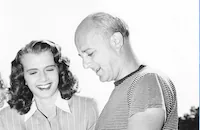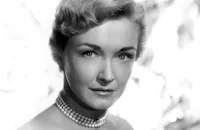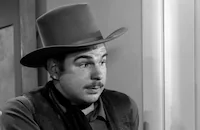The Return of the Vampire

Brief Synopsis
Cast & Crew
Lew Landers
Bela Lugosi
Frieda Inescort
Nina Foch
Miles Mander
Roland Varno
Film Details
Technical Specs

Synopsis
On the outskirts of London, in 1918, Andreas Obry, a werewolf, awakens his master, Hungarian vampire Armand Tesla, to report that the vampire's latest victim is being kept alive at a nearby sanitarium run by Lady Jane Ainsley. At the sanitarium, Lady Jane and her friend, Professor Walter Saunders, examine a slide of blood drawn from their nearly bloodless patient. After the woman dies hysterically screaming, Saunders reads an article by Hungarian Tesla, a respected scientist, about the dead returning from the grave. As Saunders reads the treatise, Tesla steals into the professor's granddaughter Nicki's room. The next morning, Saunders discovers two puncture marks on the girl's throat and realizes that she has become the vampire's latest victim. Knowing that Nicki's salvation lies in the destruction of the vampire, Saunders and Lady Jane set out to find the creature's grave. At the burial ground of the old priory, they trace footsteps to a coffin. After opening the lid, they drive a stake through the creature's heart just as Andreas enters the mausoleum and is transformed back into a human by the vampire's death. Twenty-three years later, Andreas serves Lady Jane as her faithful lab technician, and Nicki is engaged to Lady Jane's son John. Saunders has died in a plane crash. When Lady Janes tells Sir Frederick Fleet, the head of Scotland Yard, the story of Tesla and shows him Tesla's manuscript, the inspector insists upon opening the vampire's grave to investigate. Before they can proceed to the cemetery, however, a bomb that was dropped during a German air raid unearths the vampire's grave. While cleaning up the rubble, two municipal workers discover Tesla's body, pull the stake from his heart and then bury him. When Sir Frederick discovers that the graveyard has been hit by a bomb, he decides to drop the inquiry. That night, Tesla rises from the dead and summons Andreas to his grave. There, he reclaims Andreas as his servant and transforms him into a werewolf. Plotting revenge on Lady Jane through her son, Tesla sends Andreas to eliminate Dr. Hugo Bruckner, a scientist who has been smuggled out of Germany by the London underground. After Andreas returns with Bruckner's papers and clothes, Tesla assumes the dead man's identity. At an engagement party for Nicki and John, Tesla appears at the sanitarium and after he introduces himself as Bruckner, Lady Jane offers him access to her lab. That night, Tesla re-establishes his power over Nicki. The next morning, Lady Jane discovers Nicki unconscious with two puncture marks on her neck. Hurrying to the cemetery, she questions the workers, who tell her about the corpse they found with a spike through its heart. When she discovers that the body is now missing, Lady Jane is certain that the vampire lives. Although Sir Frederick listens to her story with skepticism, he dispatches two of his men to follow Andreas. When the men stop Andreas for questioning, he turns into a werewolf and flees. That night, Tesla orders Nicki to attack John. When Lady Jane discovers her son's unconscious body with puncture marks on his throat, she and Sir Frederick go to the lab to question Andreas. After Andreas flees when they discover his fur-covered hands, they decide to question Bruckner and proceed to his room at the men's club. The room is deserted, and when Lady Jane notices that the mirror has been turned toward the wall and finds Tesla's ring there, she deduces that Tesla is posing as Bruckner. As Lady Jane plays the organ at the sanitarium that night, Tesla visits her and taunts her about his power over Nicki. In response, Lady Jane calmly challenges Tesla with the power of faith and goodness and flashes an image of a crucifix at him, driving him away. Soon after, however, Sir Frederick arrives and he and Lady Jane watch helplessly as Nicki descends the stairs, summoned by Tesla's voice. Knowing that Nicki will lead them to Tesla's grave, Lady Jane insists on following her. At the cemetery, Sir Frederick sees Andreas hiding in the bushes and shoots him. At that moment, German bombers attack and Nicki is struck down by falling debris. Andreas picks her up and carries her to Tesla, and then begs for help with his wound. When Tesla refuses help and denounces him, Andreas finds a crucifix in the rubble and, now imbued with the power of goodness, becomes human again. After Andreas weakens Tesla by showing him the crucifix, a bomb falls, rendering the vampire unconscious. Pulling the vampire's body into the sunlight, Andreas drives a stake through his heart, thus freeing Nicki from his power. When Sir Frederick and Lady Jane locate Nicki, they find Andreas' body lying next to Tesla's skeleton.

Director

Lew Landers
Cast

Bela Lugosi

Frieda Inescort

Nina Foch

Miles Mander
Roland Varno

Matt Willis
Ottola Nesmith

Gilbert Emery
Leslie Denison
William Austin
Jeanne Bates

Billy Bevan
Harold Debecker
Donald Dewar
Sherlee Collier
Marianne Mosner
Audrey Manners

George Mckay
Clara Reid
Frank Dawson
Jean Fenwick
Syd Chatton
Olaf Hytten
Stanley Logan
Nelson Leigh
Crew
Lionel Banks
Earl Bellamy
Paul Borofsky
Louis Diage
Randall Faye
Howard Fogetti
Victor Greene
Griffin Jay
Kurt Neumann
Aaron Nibley
L. W. O'connell
M. W. Stoloff
John Stumar
Mario C. Tedesco
William Watts
Sam White

Film Details
Technical Specs

Articles
Return of the Vampire
When Columbia approached Lugosi for this picture, the actor jumped at the offer. He'd lately been stuck playing in cheap Monogram programmers and was excited at the notion of headlining a major studio production, even a B movie like this one. Worried that in haggling over money he might not get the part, he agreed to a salary of $3500, the same amount he had received for Dracula in 1931. In truth, Columbia chief Harry Cohn wanted Lugosi so much that he probably would have paid the actor more. The Return of the Vampire would end up the last major studio production with Lugosi in a leading role; his career would afterwards decline towards parody.
Classic film authority William Everson called the acting in The Return of the Vampire "definitely a cut above the average. Nina Foch, always an interesting actress, gave [her] part far more poignancy than the script really required. Lugosi made the most of his rich dialogue and colorful fog-accompanied entrances and exits. His Vampire this time was singularly ill-humored, and devoid of the smooth social graces of Dracula."
Nina Foch, who went on to a successful career as an actress and drama coach (and is still working as of 2006), later spoke of her first movie: "I was in a lot of drippy negligees and things and vampires were picking me up and it was all a very interesting experience. Bela Lugosi smelled of sulfur water, which he was drinking a lot. I don't know where he got it but it was Hungarian and there was a war on...So he always smelled of sulfur, which is quite a strong odor, but he was a very nice man,...very gracious to me."
The Dutch-born Foch also recalled the way Hollywood saw her in those early years: "Everyone [at Columbia] said I was such a good actress. They were so sorry I wasn't pretty or didn't have any sex appeal...the reason being that in those days women that had sex appeal had big breasts, thick lips, you know, round. And I wasn't. I was very skinny and tall and high cheek-boned and all that and I didn't look like I came from a farm in Iowa. I looked like a European, which I am. And so I was getting wonderful work because they thought I was a good actor... Only a few years later they decided I was pretty and did have sex appeal."
The Return of the Vampire was ready for release in the fall of 1943, but Cohn pushed it to Jan. 1, 1944, so as not to compete with Universal's Son of Dracula (1943), starring Lon Chaney, Jr. The Return of the Vampire performed well enough at the box office to cause other studios to start making their own B vampire films.
The story device of bringing a vampire back from the dead by removing the stake from his heart would be used again in Universal's House of Frankenstein (1944), in which John Carradine played Dracula.
Producer: Sam White
Director: Lew Landers
Screenplay: Randall Faye, Griffin Jay
Cinematography: L.W. O'Connell, John Stumar
Film Editing: Paul Borofsky
Art Direction: Lionel Banks, Victor Greene
Music: Mario Castelnuovo-Tedesco
Cast: Bela Lugosi (Armand Tesla/Dr. Hugo Bruckner), Frieda Inescort (Lady Jane Ainsley), Nina Foch (Nicki Saunders), Miles Mander (Sir Frederick Fleet), Roland Varno (John Ainsley), Matt Willis (Andreas Obry).
BW-69m.
by Jeremy Arnold
SOURCES:
Arthur Lennig, The Life and Films of Bela Lugosi

Return of the Vampire
Quotes
Trivia
Notes
This film was also reviewed as Return of the Vampire. Although a Hollywood Reporter production chart places Michael Duane in the cast, his participation in the released film has not been confirmed. The film marked actress Nina Foch's screen debut. According to a modern source, Columbia was unable to refer to the vampire as "Dracula" because Universal owned the rights to that name.














